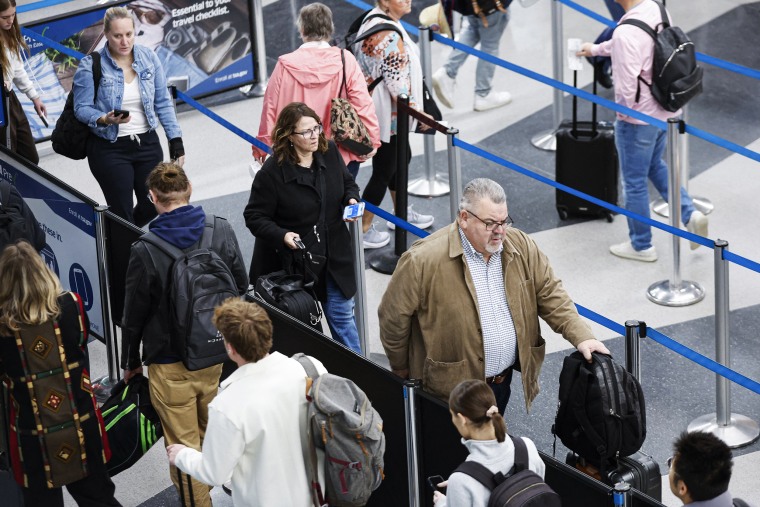With storms, snow, delayed flights and industrial action all expected in what could be the busiest holiday travel period on record, Americans set out in hope rather than expectation of stress-free journeys this week.
Two major storm systems may bring travel chaos to much of the country, dumping rain and snow across communities and major cities. Already, 17,000 flights have been canceled or delayed because of severe weather across the country since Friday.
The FlightAware website’s real-time air travel tracker — its so-called misery map — showed just 110 delays and four cancellations early Monday, with Boston the worst affected transport hub. But much more disruption is expected later Monday and through the week.
To make matters more difficult for some, service workers at North Carolina’s Charlotte Douglas International Airport walked off the job at 5 a.m. Monday, having voted to strike Friday. The Service Employees International Union (SEIU) said it planned to put an “end to poverty wages” and demand “respect on the job during the holiday travel season.”
The striking workers are ABM and Prospect Airport Services employees, whose tasks include cleaning planes and assisting passengers in wheelchairs. Workers there were also on strike in May.
The airport’s online departures board didn’t immediately show any effect of the strike. Charlotte Douglas is the ninth-busiest airport in the United States, serving more than 25 million passengers last year.
Later Monday, about 100 SEIU workers at the Los Angeles International Airport plan to rally for better pay and access to affordable health care, potentially adding to travel delays on the West Coast. The union is asking for the minimum wage to be increased from $25 to $30 an hour.
Millions of travelers already stressed
It took traveler Marc Supreme 12 hours to get from Peoria, Illinois, to Atlanta on Thursday because of ice and snow, and he says it does worry him that the week may have more bad weather in store in the Midwest.
“It does, especially because I didn’t even know that there was weather. I should have checked, so I guess it’s one of the things for the holidays, make sure you check the weather, because I had no clue that I was going to take 12 hours to get to Atlanta,” he said while waiting at the Hartsfield-Jackson Atlanta International Airport on his way back to Illinois.
College student Emma Welch had flown into Atlanta on Sunday from Chicago, where she is studying law, and said she was slightly concerned about potential travel havoc with exams looming.
“A little bit, just because of finals and stuff, but hopefully it’ll all be fine,” she said. She said she didn’t know Sunday will be one of the busiest travel days of the year when she booked her return flight. Rather than turning up three hours early to avoid any complications, she will turn up with four hours to spare instead.
Some 80 million people are set to take to the roads, railways, skies and even cruise ships this week, each making trips of more than 50 miles from home between Tuesday and next Monday.
“This will be the busiest Thanksgiving ever in terms of air travel,” TSA Administrator David Pekoske said on X. “Fortunately, our staffing is also at the highest levels that they have ever been. We are ready.”
A later Thanksgiving than usual — the final Thursday this year falling on Nov. 28 — could mean a greater travel squeeze next Monday and Tuesday as more people travel home, rather than prolonging their visits.
Many are heading South, with both Orlando and Miami’s main airports each expecting 1.9 million travelers to pass through over the 12-day travel period.

Weather woes hit festive plans
NBC meteorologist Michelle Grossman said two separate storm systems were due to bring bad weather to different parts of the country. On Monday and Tuesday, the Rockies and the Cascades could face high winds and snow, making travel difficult in mountain areas. Up to 5 inches of snow could land on Michigan’s Upper Peninsular, with other areas set to get between 1 and 5 inches.
This weather system is then set to move east, causing potential problems on roads with up to an inch of rain from the Southeast to the Northeast — although the afternoon could be drier. On Wednesday, that storm will intensify and expand, bringing a wintry mix of rain, snow and strong winds.
Thanksgiving Day will be a wet one for much of the Eastern Seaboard, from New England down to the South, while in the northern states it could be bitterly cold, reaching 26 degrees in Minnesota.
The second storm system is set to have an effect from California to New England, with widespread heavy rain and snow in mountain ranges. On Monday, the Pacific Northwest could see between 1 and 3 inches of rain and the highest parts of the southern Sierra Nevada could see 3 to 4 feet of snow.
Best times to travel?
The vast majority of trips this Thanksgiving will be on the road, with 71.7 million car journeys surpassing last year’s figure by 1.3 million — helped in no small part by lower gas prices, which could reach a national average of $3 a gallon this week.
Data from transport analysts INRIX shows that Tuesday and Wednesday afternoon will be the busiest times on the roads. But people may not realize that Thanksgiving Day itself is “typically clear.”
“We do recommend, [on] Tuesday and Wednesday try to leave early in the morning, the afternoon hours are the worst,” Aixa Diaz, AAA spokesperson, told NBC News.
“We always say traveling on the holiday itself is the best day to travel, not only because if you’re flying it’s cheaper tickets, but also there are just fewer people on the roads and at the airports,” she said.













